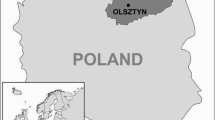Abstract
In many parts of Slovenia, the vegetation, climate and animals form an ideal natural environment for the persistence of different tick species. In this study, Ixodes ricinus ticks, the prevalent tick species in our country, are identified as the vectors of Borrelia burgdorferi in Slovenia. Ticks were collected by flagging between May and October 1990. All the ticks collected from different parts of Slovenia were I. ricinus and each one was examined individually. The ticks were tested to determine the presence of B. burgdorferi by indirect immunofluorescent assay. Among the 496 ticks examined for borreliae there were 85 adults and 411 nymphs. Twenty (23.5%) adults and 18 (4.4%) nymphs were found positive for Borreliae. This study discusses the importance of I. ricinus ticks in the role of Lyme borreliosis in Slovenia.
Similar content being viewed by others
References
Afzelius A. (1910): Verhandlungen der dermatologischen Gesellschaft zu Stockholm sitzung von 28. October 1909 - Arch. Dermatol. Syph. 101: 104.
Anderson J.F. (1989): Epizootiology of Borrelia burgdorferi in Ixodes tick vectors and reservoir hosts -Rev. Inf. Dis. 11 (Suppl. 6): 51451–51459.
Burgdorfer W., Aeschlimann A., Peter O., Hayes S.F. and Philip R.N. (1979): Ixodes ricinus: vector of a hitherto undescribed spotted fever group agent in Switzerland - Acta Tropica 36: 357–367.
Burgdorfer W. (1985): Borrelia. In: Lennette E.H., Balows A., Hausler W.J.Jr., Shadomy H.J. Jr., Shadomy H.J., editors. Manual of clinical microbiology, 4th edition, Washington DC, American Society for Microbiology, pp. 479–484.
Burgodorfer W., Hayes S.F. and Benach J.L. (1988): Development of Borrelia burgdorferi in ixodid tick vectors - Ann. N.Y. Aca. Sci. 539: 172–179.
Burgdorfer W., Hayes S.F. and Corwin D. (1989): Pathophysiology of the Lyme disease spirochete, Borrelia burgdorferi, in ixodid ticks - Rev. Inf. Dis. 11 (Suppl. 6): 51442–51450.
Craft J.E., Grodzicki R.L. and Steer A.C. (1984): Antibody response in Lyme disease: evaluation of diagnostic tests - J. Inf. Dis. 149: 789–795.
Herxheimer K. and Hartman K. (1902): Uber Acrodermatitis chronica atrophicans - Arch. Dermatol. Syph. 61: 553–556.
Kahl O., Schmidt K., Schonberg A., Laukamm-Josten U., Knulle W. and Bienzle U. (1989): Prevalence of Borrelia burgdorferi in Ixodes ricinus ticks in Berlin (West) - Zbl. Bakt. Hyg. A270: 434–440.
Lešničar J. (1981): Erythema migrans po klopovem vbodu - Zdrav. Vestn. 50: 305.
Magnarelli L.A., Anderson J.F. and Barbour A.B. (1986): The etiologic agent of Lyme disease in deer flies, horse flies and mosquitoes - J. Inf. Dis. 154: 355–358.
Magnarelli L.A., Anderson J.F. and Johnson R.C. (1987): Cross-reactivity in serologic tests for Lyme disease and other spirochetal infections - J. Inf. Dis. 156: 183–188.
Magnarelli L.A., Anderson J.F. and Fish D. (1987): Transovarial transmission of Borrelia burgdorferi in Ixodes dammini (Atari: Ixodidae) - J. Inf. Dis. 156: 234–236.
Magnarelli L.A. (1988): Serologic diagnosis of Lyme disease - Ann. N.Y. Aca. Sci. 539: 154–161.
Nakayama Y. and Spielman A. (1989): Ingestion of Lyme disease spirochetes by ticks feeding on infected hosts - J. Inf. Dis. 160: 166–167.
Oswald B. (1940): O prepoznavanju krpelja (Ixodidae) u Jugoslaviji - Vet. Arhiv. 10: 297–304.
Steer A.C., Grodzicki R.L., Kornblatt A.N., Craft J.E., Barbour A.G., Burgdorfer W., Schmid G.P. and Malawista S.E. (1983): The spirochetal etiology of Lyme disease -N. Eng. J. Med. 308: 733–740.
Strle F., Pejovnik-Pustinek A., Stanek G., Pleterski D. and Rakar R. (1989): Lyme borreliosis in Slovenia in 1986. In: Stanek G., ed. Lyme borreliosis II, Zbl. Bakt. Suppl. 18, Gustav Fischer, Stuttgart, New York, pp. 50–54.
Strle F., Cimperman J., Pejovnik-Pustinek A., Stanek G., Pleterski-Rigler D., Jereb M. and Ružić E. (1989): Lyme borreliosis: epidemiološki podaci za Sloveniju. In: Ropac D., ed. Lyme borelioza u Jogoslaviji -Zbornik Medicinske adakemije Hrvatske, Zagreb, pp. 35–43.
Strle F., Cimperman J., Pleterski-Rigler D., Stanek G., Pejovnik-Pustinek A., Jereb M. and Ružić E. (1989): Lyme borelioza u Sloveniji. In: Ropac D., ed., Lyme borelioza u Jogoslaviji - Zbornik Medicinske adakemije Hrvatske, Zagreb, pp.. 93–100.
Strle F., Preac-Mursić V., Ružić E., Wilske B. and Cimperman J. (1991): Isolation of Borrelia burgdorferi from a skin lesion in a patient with granuloma annulare - Infection 19: 351–352.
Strle F., Pleterksi-Rigler D., Stanek G., Pejovnik-Pustinek A., Ružić E. and Cimperman J. (1992): Solitary borrelial lymphocytoma: report of 36 cases -Infection 20: 201–206.
Tovornik D. (1973): O naravnih žariščih klopnega meningoencefalitisa u Sloveniji. In: Simpozij o klopnem meningoencefalitisu. Slovensko zdravniško društvo - Infekcijski odd. bolnice Celje, pp. 23–29.
Tovornik D. (1988): The significance of the roe-deer (Capreolus capreolus Linne, 1758) as the host and disseminator of ixodid ticks in SR Slovena (Yugoslavia) - Biol. Vestn. 36: 85–94.
Tovornik D. (1989): Red squirrel (Sciurus vulgaris Linne, 1758) and fat dormouse (Glis glis Linne, 1766) as hosts of ixodid ticks in Slovenia (Yugoslavia) -Biol. Vestn. 37: 83–96.
Tovornik D. (1990): The significance of birds (Aves) as the hosts and disseminators of ixodid ticks (Yugoslavia) - Biol. Vestn. 38: 77–108.
Wilske B., Steinhuber R., Fingerle V., Schierz G., Preac-Mursic V., Vanek E. and Lorbeer B. (1987): Lyme-Borreliose in Suddeutschland D.M.W. - 112: 1730–1736.
Wilske B., Preac-Mursič V. and Schierz G. (1988): Lyme-Borreliose - Die Gelben Hefte 28: 146–159.
Author information
Authors and Affiliations
Rights and permissions
About this article
Cite this article
Ružić-Sablijić, E., Strle, F. & Cimperman, J. The Ixodes ricinus tick as a vector of Borrelia burgdorferi in Slovenia. Eur J Epidemiol 9, 396–400 (1993). https://doi.org/10.1007/BF00157396
Issue Date:
DOI: https://doi.org/10.1007/BF00157396




